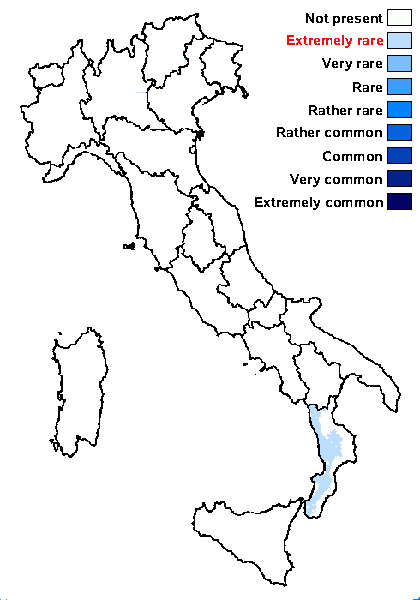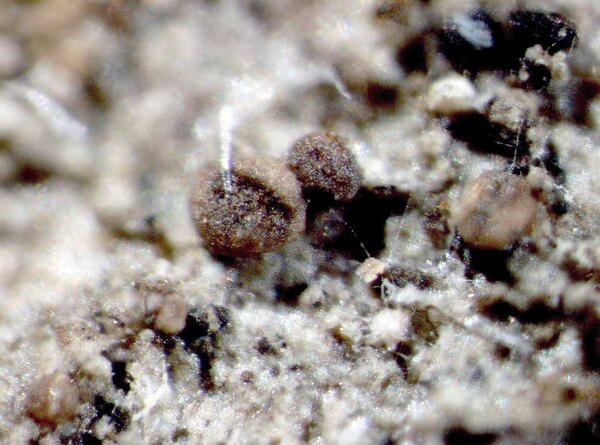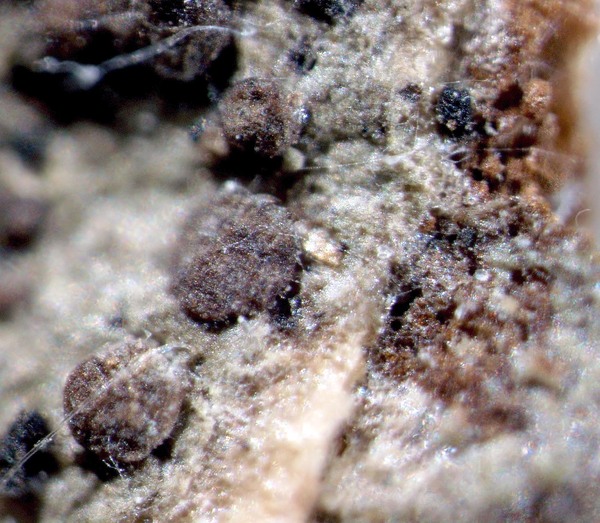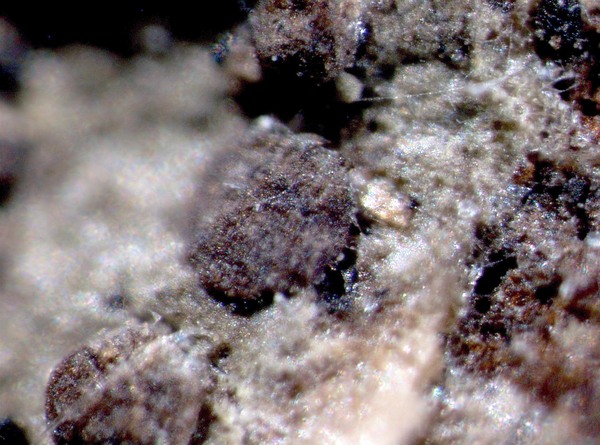Fellhaneropsis vezdae (Coppins & P. James) Sérus. & Coppins
Lichenologist, 28: 208, 1996. Basionym: Bacidia vezdae Coppins & P. James - Lichenologist, 10: 190, 1978.
Synonyms: Fellhanera vezdae (Coppins & P. James) V. Wirth
Distribution: S - Cal (Puntillo & Vězda 1994, Puntillo 1995, 1996, 2000).
Description: Thallus crustose, ecorticate, thinly episubstratic, pale greenish grey. Apothecia biatorine, constricted at base, 0.2-0.4 mm across, pinkish brown to grey-brown, at first with a flat, sometimes tuberculate disc and an evident proper margin, but soon becoming convex and immarginate. Proper exciple of vertically arranged hyphae with elliptical to polyhedral cells, to 15 µm wide laterally, colourless throughout or very pale brown in innermost part; epithecium reddish brown; hymenium colourless or pale brown, 40-45 µm high, I+ blue; paraphyses branched and anastomosing, 0.5-1 µm thick, forming a densely interwoven network around the ascus tips; hypothecium thin, dark brown. Asci 8-spored, clavate, with a K/I+ blue apical dome containing a darker blue, tubular ring-structure, and an amyloid coat, Byssoloma-type. Ascospores 3-7-septate, hyaline, acicular-fusiform, slightly curved, 30-42 x 3-4.5 µm. Pycnidia frequent, sessile, globose to flask-shaped, pink-brown to finally brown-black, up to 0.2 mm across, with a relatively wide ostiole. Conidia thread-like, colourless, simple or indistinctly septate, curved, (20-)30-43 x 0.5-1 µm. Photobiont chlorococcoid, the cells 4-7 µm wide. Spot tests: thallus K-, C-, KC-, P-, UV-. Chemistry: without lichen substances.Note: a mild-temperate lichen found on bark of broad-leaved (especially Quercus) and coniferous (e.g. Abies) trees in very humid, open forests, especially on basal parts of trunks, sometimes foliicolous (e.g. in Calabria). It is included in the Italian red list of epiphytic lichens as “Critically Endangered” (Nascimbene & al. 2013c).
Growth form: Crustose
Substrata: bark and leaves
Photobiont: green algae other than Trentepohlia
Reproductive strategy: mainly sexual, or asexual by conidia and thalloconidia
Most common in areas with a humid-warm climate (e.g. most of Tyrrenian Italy)
Commonnes-rarity: (info)
Alpine belt: absent
Subalpine belt: absent
Oromediterranean belt: absent
Montane belt: extremely rare
Submediterranean belt: absent
Padanian area: absent
Humid submediterranean belt: extremely rare
Humid mediterranean belt: absent
Dry mediterranean belt: absent

Predictive model
Herbarium samples
Growth form: Crustose
Substrata: bark and leaves
Photobiont: green algae other than Trentepohlia
Reproductive strategy: mainly sexual, or asexual by conidia and thalloconidia
Most common in areas with a humid-warm climate (e.g. most of Tyrrenian Italy)
Commonnes-rarity: (info)
Alpine belt: absent
Subalpine belt: absent
Oromediterranean belt: absent
Montane belt: extremely rare
Submediterranean belt: absent
Padanian area: absent
Humid submediterranean belt: extremely rare
Humid mediterranean belt: absent
Dry mediterranean belt: absent

Predictive model
| Herbarium samples |
 INDEX FUNGORUM
INDEX FUNGORUM
 GBIF
GBIF





